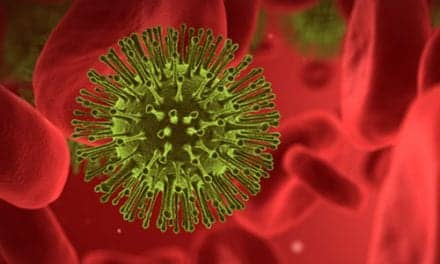Prospects for AIDS patients seem to be growing more favorable each year.
Since the beginning of the HIV epidemic in the early 1980s, the number of people living with advanced HIV disease or AIDS has increased each year. In spite of unprecedented advances in the treatment of HIV disease and national efforts to educate the public about how HIV is transmitted, the number of people living with AIDS increased 11.2 percent between 1995 and 1996,1 from 215,000 to 239,000. The prospects for people infected with HIV are, nonetheless, more favorable today than at any other time during the HIV epidemic. Combination antiretroviral therapy with protease inhibitors-widely available since early 1995-can reduce HIV in the blood to undetectable levels and slow the progression of HIV disease.2,3 With the broad availability of this highly effective form of treatment, the number of people diagnosed with AIDS-related opportunistic infections decreased between 1995 and 1996,1 and for the first time since the beginning of the HIV epidemic, the number of reported deaths from AIDS declined. It will be interesting to see how the newest advances in HIV disease treatment will affect the diagnosis and management of HIV-related lung diseases.
CHANGES IN LUNG DISEASE
Even before the widespread use of combination antiretroviral therapy, there had been major changes in the types and frequency of HIV-related pulmonary diseases seen since the beginning of the epidemic. In 1983, the National Institutes of Health sponsored a workshop on the pulmonary complications of AIDS. At that time, Pneumocystis carinii pneumonia (PCP) was by far the most frequent pulmonary complication, accounting for about 75 percent of all pulmonary diagnoses. Other diagnoses included Kaposi’s sarcoma, Mycobacterium avium complex (MAC), fungal pneumonias, tuberculosis (TB), bacterial pneumonia, and other unusual infections such as pulmonary toxoplasmosis or herpes simplex virus infection. In the late 1980s, the frequency of PCP began to decline and the frequency of HIV-related bacterial pneumonia increased. By 1994, in the National Multicenter Pulmonary Complications of HIV Infection study, PCP accounted for only half of all pulmonary diagnoses, whereas bacterial pneumonia made up about one third. Other changes included a greater prominence of TB (associated with a public health crisis in this area in the early 1990s); the fact that MAC was no longer considered a primary pulmonary infection; and the recognition of a new disorder, nonspecific interstitial pneumonitis.
The changing profile of HIV-related pulmonary disorders has been attributed to changes in the definition of AIDS, shifting demographic and behavioral characteristics in people with HIV disease, and widespread PCP prophylaxis. Since the early 1980s, the definition of AIDS has expanded from including a few opportunistic infections, PCP being the most frequent, to the 1993 definition of a CD4 count of less than 200 cells/mL. This change in definition has caused an apparent increase in AIDS diagnoses by including cases that would not have been covered by the previous diagnostic criteria. In addition, changes in the demographic and behavioral characteristics associated with HIV infection have contributed to the changing spectrum of pulmonary complications. In the United States, for example, the HIV-infected population expanded from early detection primarily among white homosexual males to include injecting drug users, people of color, and women. We know that injecting drug users have a high rate of bacterial pneumonia, while it seems that African Americans-and, possibly, women-have a lower risk for PCP.4 The final factor in this change is that PCP prophylaxis, which is clearly effective, has become widespread among HIV patients with CD4 cell counts of less than 200/mL. PCP prophylaxis increased rapidly between 1988 and 1990; by 1991, it was used by more than 80 percent of HIV-infected participants in the Pulmonary Complications of HIV Infection study5 who had CD4 cell counts of less than 200/mL.
LOWER RESPIRATORY TRACT INFECTIONS
Between roughly 1989 and 1994, the Pulmonary Complications of HIV Infection study5 observed the types and incidence of respiratory disorders in a large cohort of individuals with all stages of HIV disease. During this time, the incidence of lower respiratory infections increased. These infections included acute bronchitis, bacterial pneumonia, PCP, TB, and other uncommon opportunistic pulmonary infections such as pulmonary aspergillosis, cryptococcosis, and toxoplasmosis. Study participants were grouped according to their CD4 counts at the time of study enrollment. In participants who entered the study with CD4 counts of 500/mL or more, acute bronchitis was clearly the dominant lower respiratory infection throughout the study period. In those who entered with CD4 cell counts of 200 to 499/mL, acute bronchitis was also the most frequent lower respiratory illness. The most dramatic finding was a continuous and parallel increase in the yearly incidence of PCP and bacterial pneumonia. These rates increased an average of 30 percent a year. In participants with study-entry CD4 counts of less than 200/mL, the yearly incidence of acute bronchitis, bacterial pneumonia, and PCP was high throughout the study (despite PCP prophylaxis use by most subjects). The incidence rates fluctuated each year, without any time trend. Other pulmonary opportunistic infections increased during the study. The incidence of TB was low in all three groups, but it was significantly higher in participants with CD4 counts of less than 200/mL.
NEW DEVELOPMENTS IN TREATMENT
Two important new developments have greatly affected the management of HIV disease. The first is the ability to measure plasma HIV RNA levels reliably; the second is major advances in antiretroviral treatment, including expansion of the types of reverse transcriptase inhibitors available and the introduction of a new class of anti-HIV drugs, the protease inhibitors. Combination therapy using reverse transcriptase inhibitors and protease inhibitors has had a profound effect on the current prognosis and quality of life of HIV-infected people.
During the early stages of HIV infection, HIV replication within CD4 lymphocytes leads to the malfunction and death of these cells. In response to the infection, however, there is new CD4 lymphocyte production and the killing of HIV by immune cells. The rates of HIV- and CD4-cell production are enormous, and the levels of each are determined by the balance of their production and destruction. The level of HIV in the blood, or viral load, predicts HIV disease progression, and patients who have HIV levels of 10,000 copies/mL or more have a moderate to high risk of progression to AIDS within a few years.
Three classes of antiretroviral drugs for the treatment of HIV are available. Each acts at a specific site of HIV replication. The stages of HIV reproduction include attachment of HIV to the CD4 cell membrane and entry into the cell; reverse transcription of the viral RNA to DNA using an essential enzyme, reverse transcriptase; insertion of the DNA into the host DNA to form a template for the production of HIV RNA and proteins; and, finally, the assembly of HIV near the cell surface and release of the HIV particles by budding from the cell membrane.
The most established class of antiretroviral agents is that of the nucleoside- analogue reverse transcriptase inhibitors (NRTI), including zidovudine, lamivudine, didanosine, zalcitabine, and stavudine. A new class, acting at the same site, includes the nonnucleoside reverse transcriptase inhibitors nevirapine and delavirdine. The protease inhibitors act at a different site. They bind HIV protease so that it cannot cleave two precursor polyproteins, which it must do to convert immature viral particles to mature infectious viruses. There are four protease inhibitors: saquinavir mesylate, indinavir sulfate, ritonavir, and nelfinavir.
The availability of a greater variety of drugs with different mechanisms of action has led to combination antiretroviral therapy. A number of types of drug combinations may be used. The triple combinations use two NRTI drugs plus either a protease inhibitor or a third NRTI drug. Combination therapy is very effective in reducing HIV in the blood, often to undetectable levels.
Recommendations as to who should receive combination therapy were released in June 1997.6 All patients with more than 5,000 to 10,000 copies/mL of HIV should be treated, and combination therapy should be considered for any patient with detectable plasma HIV. Treatment can be deferred for patients with low plasma HIV RNA levels and high CD4 counts, but they should be reevaluated every 3 to 6 months. Antiretroviral drugs should not be given alone as an initial treatment; combination therapy should be used (ie, monotherapy should be avoided).
The first significant decline in deaths since the HIV epidemic was first recognized in 1981 occurred in 1996, with the sharpest decline among white men. The decline in the number of deaths among women and minorities was less extensive. The same year also marked a decline in the number of opportunistic infections.1 This has been attributed to new antiretroviral therapy, better HIV prevention, and prophylaxis for the more common opportunistic infections. A reduction in respiratory infections that occur with advanced HIV immunodeficiency, such as PCP, bacterial pneumonia, TB, and uncommon opportunistic pulmonary infections, should follow.
As promising as combination therapy is, it does have its pitfalls. Combination regimens require that a number of pills be taken on a very regular basis two or three times a day. Side effects are common, and for patients taking three drugs, the chance of experiencing one or more side effects is high. Therefore, the success of HIV treatment using combination antiretroviral therapy will be limited by several factors. It is not effective for all HIV patients, especially those who have previously received monotherapy using one or more of the drugs included in the combination regimen. Nonadherence or suboptimal dosing may lead to accelerated resistance and treatment failure. The high frequency of drug intolerance may impair adherence, and, in fact, some patients may prefer taking their chances with HIV progression and death to putting up with the long-term side effects of drug therapy. The problem of access to combination therapy also exists for the disadvantaged and for those lacking sufficient knowledge of HIV disease. For these reasons, we can expect to continue to see HIV-related pulmonary disorders, although they are most likely to occur with less frequency.
HIV-RELATED ACUTE BRONCHITIS
Acute bronchitis, the most frequent HIV-related lower respiratory infection, occurs significantly more often in HIV-infected patients than in HIV-seronegative individuals with similar risk factors. The incidence of acute bronchitis is high in HIV-infected people at all stages of the disease and with all HIV risk factors. Among people with HIV disease, the rates of acute bronchitis are higher in active smokers than in former smokers or nonsmokers. The clinical presentation is the same as that seen in people without HIV disease: an acute lower respiratory illness with a cough that produces purulent sputum and no evidence of pneumonia on a plain chest roentgenogram. Infectious bronchitis can be recognized on computed tomography (CT) studies by findings such as dilatation and thickening of bronchial walls and small, ill-defined densities representing bronchioles impacted with inflammatory material.7 Treatment for acute bronchitis in HIV-infected patients is the same as for people without HIV disease: a broad-spectrum antibiotic-such as amoxicillin, a second-generation cephalosporin, or a macrolide-is taken for 10 to 14 days.
PCP
PCP infection rarely occurs in HIV-infected patients with CD4 cell counts of more than 200/mL. It often has an indolent course, growing progressively worse over a period of weeks. The most common symptoms are fever, a nonproductive cough, dyspnea, and chest tightness. Many patients note fatigue and weight loss. The physical examination may be normal, although some patients have fine rales or wheezing. Signs of advanced HIV infection, like thrush or Kaposi’s sarcoma, may be present.
Most, but not all, HIV-infected patients with PCP have abnormal chest roentgenograms. Findings may be subtle, especially in early disease, and difficult to interpret if no prior chest roentgenogram is available for comparison. The feature most commonly seen is diffuse, bilateral interstitial and alveolar infiltration, but other patterns can also be seen, including involvement of only the upper lobes (associated with prophylactic aerosolized pentamidine use), cavities and blebs, and pneumothorax.
Presumptive treatment of PCP in HIV- infected patients at high risk and with typical clinical characteristics has been increasingly accepted. Because chest CT imaging usually reveals highly typical patterns in PCP, this modality can be used to substantiate a presumptive PCP diagnosis. It should be noted, however, that even patients who have a good outcome with presumptive treatment may require a definitive diagnosis to document that they have sufficiently advanced HIV disease to qualify for some types of financial aid and services. For such patients, and for those in whom the clinical presentation is less typical, a refined sputum induction technique can provide a reasonably high diagnostic yield. This technique uses an ultrasonic nebulizer to deliver 3% 100hypertonic saline for 20 to 60 minutes to facilitate expectoration of a lower-respiratory tract sample.
Specimens that have a clear, foamy appearance are generally more useful in providing a diagnosis. In patients with bronchitis or bacterial pneumonia, purulent sputum may hamper the ability to sample the distal lung, so the procedure may not be effective until treatment of these infections with an antibacterial antibiotic has been provided. Application of the proper technique for processing the specimens is also crucial. Use of the mucolytic agent dithiothreitol and centrifugation increases sensitivity considerably. The yield of sputum induction for detecting P carinii through conventional staining is up to 808in some institutions, and up to 95 percent when monoclonal antibody staining is used.
Fiberoptic bronchoscopy has been widely used to diagnose PCP in HIV-infected patients. Bronchoalveolar lavage through the bronchoscope has a diagnostic yield of up to 90 percent; when combined with transbronchial biopsy, its yield may approach 1001 These bronchoscopic procedures retain their diagnostic value if empirical therapy has been started, except after prolonged periods (more than 1 to 2 weeks).
The conventional treatment for PCP has been trimethoprim-sulfamethoxazole (TMP-SMZ) or parenteral pentamidine. Because P carinii infection tends to be cleared slowly, treatment duration is usually 3 weeks. TMP-SMZ is currently considered the drug of choice, with pentamidine being reserved for patients who fail to respond or develop intolerable side effects. Because it is well absorbed from the gastrointestinal tract, it can be given orally or parenterally. Patients with more severe episodes of PCP are often given adjunctive treatment with corticosteroids with a tapering corticosteroid course of 21 days or less.
PCP prophylaxis should be given to all HIV-infected patients who have a CD4 cell count of less than 200/mL or who have had an episode of PCP. TMP-SMZ is the most beneficial prophylactic agent, although aerosolized pentamidine, dapsone, and other less efficacious drugs can be used in patients who do not tolerate TMP-SMZ. Aerosol pentamidine was the therapy of choice in the late 1980s, but fell out of favor due to side effects and questionable even distribution throughout the lungs.
BACTERIAL PNEUMONIA
In the majority of cases, bacterial pneumonia in HIV-infected people is community acquired, caused by Streptococcus pneumoniae, Haemophilus influenzae, and, less commonly, Staphylococcus aureus, Moraxella catarrhalis, group B streptococci, or Klebsiella pneumoniae. Legionella spp may cause pneumonia in HIV-infected patients, but not more frequently than in noninfected people.
The clinical and radiographic features of bacterial pneumonia-fever, cough, purulent sputum, and focal consolidation-are essentially the same as for non-HIV-infected people. In both groups, no etiologic agent may be isolated in 60 percent to 70 percent of clinically apparent bacterial pneumonias.
Most HIV-infected patients with bacterial pneumonia respond to specific antibiotic therapy, although recurrences are more common. The antibiotic choice should not be affected by the presence of HIV infection, although a longer treatment course may be indicated for patients with severe or recurrent pneumonia.
OTHER PULMONARY INFECTIONS
HIV infection has been considered an important contributor to the resurgence of TB in the early 1990s. TB may present atypically, especially in advanced HIV disease. Therefore, in all patients with HIV disease and pulmonary infection, this diagnosis must be considered; until it has been excluded, precautions should be taken to prevent exposure to other people.
A variety of uncommon pulmonary infections may occur in HIV-infected patients, including herpesvirus infections (especially cytomegalovirus); fungal infections (cryptococcosis, histoplasmosis, coccidioidomycosis, and aspergillosis); and pulmonary toxoplasmosis. These infections usually affect patients with advanced HIV disease.
REFERENCES
- Centers for Disease Control and Prevention. HIV/AIDS Surveillance Report. 1997;9:1-37.
- Gulik RM, Mellors JW, Havlir D, et al. Treatment with indinavir, zidovudine, and lamivudine in adults with human immunodeficiency virus infection and prior antiretroviral therapy. N Eng J Med. 1997;337:734-739.
- Hammer SM, Squires KE, Hughes MD, et al. A controlled trial of two nucleoside analogues plus indinavir in persons with human immunodeficiency virus infection and CD4 cell counts of 200 per cubic millimeter or less. N Eng J Med. 1997;337:725-733.
- Stansell JD, Osmond DH, Charlebois E, et al. Predictors of Pneumocystis carinii pneumonia in HIV-infected persons. Am J Respir Crit Care Med. 1997;155:60-66.
- Wallace JM, Hansen NI, LaVange L, et al. Respiratory disease trends in the pulmonary complications of HIV infection study group. Am J Respir Crit Care Med. 1997;155:72-80.
- Carpenter CCJ, Fischl MA, Hammer SM, et al. Antiretroviral therapy for HIV infection in 1997. Updated recommendations of the International AIDS Society Panel-USA Panel. JAMA. 1997;277:1962-1969.
- McGuinness G, Gruden JF, Bhalla M, Harkin TJ, Jagirdar JS, Naidich D. AIDS-related airway disease. AJR Am J Roentgenol. 1997;168:67-77.
— r









